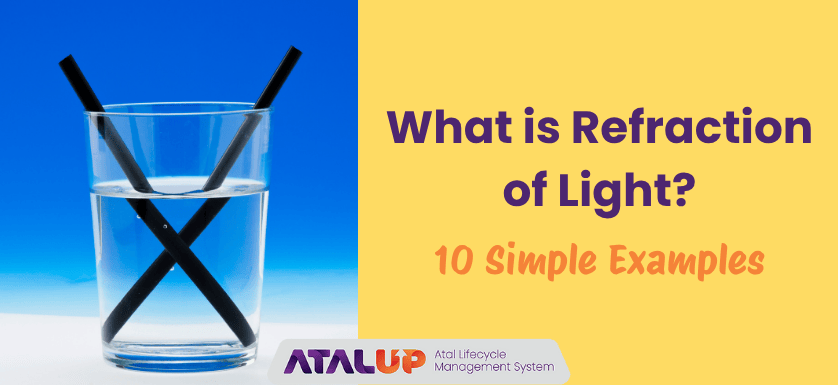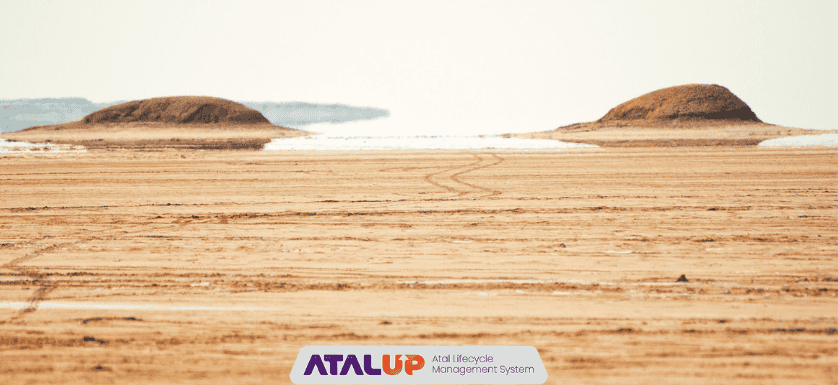
Ever seen a pencil look bent in a glass of water? Or spotted a rainbow on a sunny day after rain? That’s not magic, it’s science. More specifically, it’s called refraction of light. In this blog, we’ll explain what is refraction of light, how it’s different from reflection, and give you 10 real-life examples. Let’s make light concepts easy and practical!
What is Refraction of Light?
Simple Definition of Refraction
Refraction of light is the bending of light when it moves from one transparent material to another. This happens because light travels at different speeds in different mediums, like air, water, or glass.
When light passes from air (where it travels fast) into water (where it slows down), it changes direction. This change in direction is called refraction.
Everyday Situations Where Refraction Happens
Think of a straw in a glass. It looks bent or broken, because the light from the straw bends when it leaves the water and enters the air. Or when you wear glasses, the lenses bend the light so you can see clearly. These are simple signs of refraction of light in real life.
Why Does Refraction Occur?
Change in Medium and Light Speed
Light travels at different speeds in different materials. When it moves from a less dense medium like air into a denser one like water, it slows down. This change in speed causes the light to bend.
Angle of Incidence and Density Factors
How much the light bends depends on:
- The angle at which it hits the surface (called angle of incidence)
- The difference in density between the two materials
A bigger change in speed or angle means more bending. That’s why lenses are shaped carefully to bend light in just the right way.
10 Real-Life Examples of Refraction of Light
1. Pencil Appears Bent in Water
Place a pencil in a glass of water. It appears bent or shifted. This happens due to refraction as light travels from water to air.
2. Rainbow Formation
Rainbows form when sunlight passes through water droplets in the air. Light bends (refracts), reflects inside the droplet, and refracts again, creating a spectrum.
3. Lenses in Eyeglasses
Glasses correct vision by bending light. Concave lenses spread out light rays for nearsighted people, and convex lenses focus them for farsighted ones.
4. Camera Lens Focus
Camera lenses bend light to focus images sharply onto a sensor. Adjusting the lens changes the angle and degree of refraction.
5. Prism Splitting Light
When white light enters a prism, it bends and splits into different colors. Each color bends at a slightly different angle because of its wavelength.
6. Twinkling of Stars
Stars twinkle due to refraction caused by layers of air in Earth’s atmosphere. Light bends slightly as it travels through varying air densities.
7. Mirage in the Desert
On hot days, you might see water on the road. That’s a mirage. Light from the sky bends due to hot air near the surface, creating an illusion.

8. Contact Lenses
Just like glasses, contact lenses bend light before it reaches the eye. They help focus light properly on the retina for clearer vision.
9. Optical Fiber Communication
Refraction and reflection keep light signals inside optical fibers. This is how high-speed internet reaches homes and offices.
10. Projector Lenses
Projectors use lenses to bend and focus light. This enlarges images and projects them onto screens with sharp clarity.
What is Reflection of Light?
Basic Meaning with Examples
Reflection of light happens when light bounces off a surface instead of passing through it. The most common example is looking in a mirror.
When light hits a smooth surface, it reflects at the same angle it arrived. This is called the Law of Reflection.
Laws of Reflection
There are two main rules:
- The angle of incidence equals the angle of reflection.
- The incident ray, reflected ray, and the normal (perpendicular line) all lie in the same plane.
Refraction vs Reflection – Key Differences
Medium Interaction
- Reflection happens on the same surface, light stays in the same medium.
- Refraction happens when light enters a different medium.
Light Behavior
- In reflection, light bounces back.
- In refraction, light bends and continues in a new direction.
Real-World Applications
- Reflection: Mirrors, periscopes, solar cookers.
- Refraction: Eyeglasses, telescopes, microscopes, camera lenses.
Understanding the difference between refraction vs reflection helps in learning how lenses, mirrors, and even human vision work.
Importance of Refraction and Reflection in STEM Learning
How These Concepts Are Used in Tech
From designing contact lenses and cameras to building telescopes and fiber-optic cables, refraction and reflection are essential in science and technology.
Understanding both helps students think beyond textbooks and connect physics to the real world.
Simple Experiments with ATAL Tinkering Labs
In Atal Tinkering Labs (ATLs), students can perform hands-on activities to understand these concepts. For example:
- Creating a DIY periscope (reflection)
- Using a water glass and straw to explore refraction
- Splitting white light with a prism
These projects turn abstract ideas into visible, understandable science.
How ATALUP App Makes These Concepts Easy for Students
Hands-On STEM Activities Using Refraction and Reflection
The ATALUP STEM App is designed for students to explore science using low-cost, home-based materials. Refraction and reflection experiments are part of daily STEM challenges, making learning fun and practical.
Learning Science at Home with the ATALUP App
Even if your school doesn’t have an ATL Lab yet, you can still begin your STEM journey. With ATALUP, students can try virtual activities, track progress, and build confidence before entering an ATL Lab.
Download the app now
Android: Play Store and iPhone: Apple Store
Conclusion:
Understanding what is refraction of light and how it differs from reflection is more than a school lesson, it’s a step into the world of innovation. And with ATALUP and ATL Labs, this learning becomes accessible, exciting, and hands-on.